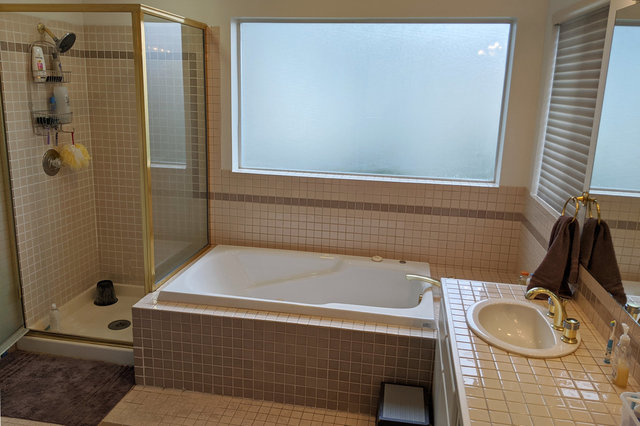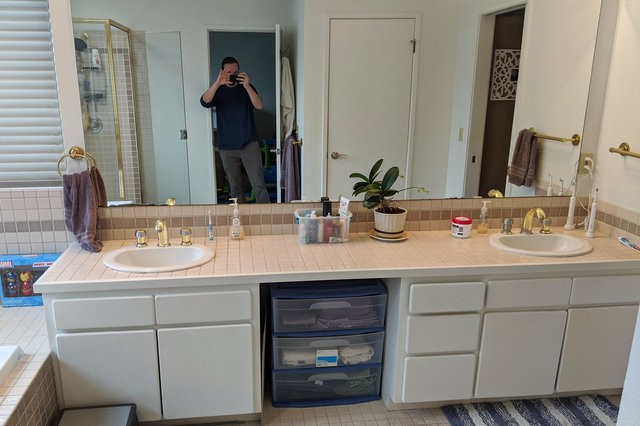Tile
Started: 2020-07-07 23:16:21
Submitted: 2020-07-08 00:49:14
Visibility: World-readable
In which the intrepid narrator considers what to do with water damage in his master bathroom
I didn't really intend to remodel my bathroom by myself in the middle of a global pandemic. But one thing led to another, and then my impromptu project absorbed all of my non-working hours in the month of June. It's now the second week in July and I'm still neck-deep in the project. I can see the light at the end of the tunnel but this project is not done yet.
One of the most striking features of the Wallingford Eighties House was its very-eighties master bath. This bath was the pinnacle of eighties tile excess: every available surface was covered in two-inch tile, in a a simple pattern with an accent color running in a strip just below the top of the tile, continuing into the shower in one cohesive tile installation. The faucets were a brilliant bronze that was beginning to show its age (the same faucets that I replaced, with some effort, in the second-floor half-bath in the fall).
In January, as we considered the prospect of selling our house to execute our return to the Bay Area, we talked to our realtor about things we might want to improve in the house before selling it. One of the problems we identified was water damage around the shower in the master bath: the tile on the floor in front of the shower was clearly beginning to sag, signaling damage to the subfloor (this is the discolored grout between the tiles to the right of the shower in the picture; it was noticeably soft to the touch); and when I looked closer at the tile I could see that it had been repaired at least once before: there was a three-tile-wide section composed of a different kind of tile that was almost, but not exactly, a color match. (This was normally hidden by our bath mat right in front of the shower, so I didn't actually notice it on a regular basis.) The vertical tile mounted to the enclosure around the tub had also been repaired: the tile was sealed with white caulk, not gray grout, also visible at the top right of the picture below.
There were more obvious problems inside the shower: the panel to the right of the shower, under the enclosure around the tub and opposite the shower head (at the right of the picture here) had separated from the shower pan and was obviously rusting. When we moved in this was open at the bottom and rusting away; we used white duct tape to attempt to seal it to the shower pan, which seemed to work, except that the panel was still rusting (and the whole shower was obviously leaking, evidenced by the soft-to-the-touch tile floor in front of the shower), and we were fairly confident any competent home inspection was going to identify this as a problem that would need to be fixed.
And then there was the tile at the back of the shower. It's not totally obvious in the picture but the tile was bulging in from the wall in two separate places, on the back right and back left of the wall facing us in the picture above (and, as I look closer, the tile inside the shower on the top-right side was also replaced and sealed with caulk, not grout, signaling a low-budget prior repair). This portended cataclysmic levels of water damage in the wall behind: the only way to be sure was to remove all of the tile and look into the wall behind and then follow the rabbit hole of water damage as deep as it went.
In January this was not a project I was planning on undertaking on my own, but we talked to a contractor who seemed interested in doing the work for us, as soon as we figured out what we wanted. We went back and forth about how much work we wanted to do and how to make it look good with the rest of the bathroom. The biggest problem was that the tile was built to make the whole bathroom look like it belonged together (to the extent that ugly eighties tile looks good at all), and since we could no longer find that tile we tried to figure out whether we could find something to coordinate with it, because we didn't want to retile the entire bathroom.
We took an interesting trip to a tile shop in Seattle that found some larger blush-colored tiles that were at least in the right color family, and came up with some ideas how the new tile in the shower would try to merge with the old tile around the bathtub and sink; but it didn't really look quite right to me. We let the project linger (our contractor was not especially responsive to e-mail) until the end of February, when I called him and got a slot on his calendar to come take a look at our bathroom again so we could talk about what we wanted to do with it -- and then he canceled, out of an abundance of caution with a possible exposure to COVID-19, and the project stalled for three months while the pandemic overtook us.





